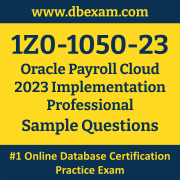01. Which legislative data group (LDG) description is incorrect?
a) An LDG can be associated to multiple cost allocation key flexfield structures.
b) An LDG can contain many legal entities that act as payroll statutory units.
c) An LDG is associated with a legislative code and currency.
d) An LDG marks a legislation in which payroll is processed.
02. How should you change the order of the task displayed within the payroll flows checklist?
a) Amend both the sequence of the tasks on the task definition page and the task
b) Amend the task sequence on the task sequencing page.
c) Amend the sequence of the tasks within the task definition page.
d) Amend both the task sequence on the task sequencing page and the sequence within the edit task details page.
03. You have a requirement to stop the new entries from being created for an element and to continue the existing entries. How do you achieve this?
a) End date the element definition.
b) Change the effective date to the required date and select the “Closed for entry” check box.
c) You cannot achieve this requirement because you need to continue the existing element entries.
d) Delete the element definition and re-create it with a different effective date.
04. A customer is implementing the two-tier employment model. At what level are payroll run results captured in cloud payroll?
a) Payroll Relationship only
b) Work Relationship and Assignment
c) Assignment only
d) Payroll Relationship and Assignment
05. Where do you define a custom schedule to be used during payroll flow submission?
a) Within Manage Flow Patterns, create a custom schedule and associate it with the flow pattern.
b) Within Manage Fast Formula, create a formula that defines the required schedule.
c) Within Manage Time Definitions, create a schedule using the type “Time Span”.
d) Within Manage Run Types, create a schedule of the category “Normal”.
06. If the status of a task on the checklist is “On Hold”, what actions can be taken against that task?
a) Mark for Retry
b) Skip, Retry, and Submit
c) Resubmit, Force Resubmit, and Skip
d) Resubmit, Rollback, and Skip
07. What happens if the costing process does not find a value for a segment defined as mandatory, and you create a suspense account at Payroll level?
a) Costing results display a blank (null) value in the segment.
b) Calculation displays an error, and the person’s results are not costed.
c) Costing results are placed into suspense account.
d) No costing results are created for the person.
08. You are a payroll customer but when you have created an earnings element using the Manage Elements feature it has not created a pay value input value.
What is the reason for this?
a) The selected extension in Manage Features by Country or Territory was set to “Human Resources or None”.
b) The selected extension in Manage Features by Country or Territory was set to “Payroll”.
c) The earnings element template always creates “Pay Value” as the input value.
d) The selected extension in Manage Features by Country or Territory was set to “Payroll Interface”.
09. An element is defined with costing type as “Fixed Costing”. Which costing levels are considered while building cost account?
a) Payroll, Department, Element Eligibility
b) Payroll, Person Element Entry, Department, Job or Position, Person, Element Eligibility
c) Payroll, Element Eligibility, Department, Element Entry
d) Payroll, Element Eligibility, Element Entry
10. The element template has created a “Results” element for a voluntary deduction element along with the base element.
a) Distributor element
b) Calculator element
c) Base element
d) Results element
 The Oracle Payroll Cloud Implementation Professional (1Z0-1050-23) Sample Question Set is designed to help you prepare for the Oracle Payroll Cloud 2023 Certified Implementation Professional (OCP) certification exam. To become familiar with the actual Oracle Certification exam environment, we suggest you try our Sample Oracle 1Z0-1050-23 Certification Practice Exam.
The Oracle Payroll Cloud Implementation Professional (1Z0-1050-23) Sample Question Set is designed to help you prepare for the Oracle Payroll Cloud 2023 Certified Implementation Professional (OCP) certification exam. To become familiar with the actual Oracle Certification exam environment, we suggest you try our Sample Oracle 1Z0-1050-23 Certification Practice Exam.